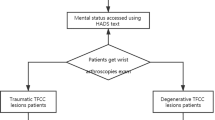Abstract
Our purpose was to study the relationship between latent trigger points (LTrP) and levels of depression in healthy subjects. A total of 76 healthy subjects consisting of 40 men and 36 women (mean age, 25.4 ± 4.8 years; age range, 19–42 years) from the School of Physical Therapy and Rehabilitation and the Orthopaedics and Traumatology Department of Istanbul University Medical Faculty were selected for the study. Latent trigger points on the scapular muscles of each subject were evaluated. The upper and middle trapezius, supraspinatus, serratus anterior, and rhomboideus muscles were examined respectively, by palpation with the thumb, to determine whether there was pain. The first group consisted of 30 subjects (20 men and 10 women; mean age, 24.2 ± 5.02 years) who had previously been diagnosed as negative after an LTrP examination (control group), while the second group consisted of 28 subjects (12 men and 16 women; mean age, 23.6 ± 2.24 years) who had been diagnosed with at least five LTrPs. The third group consisted of 18 subjects (8 men and 10 women; mean age, 26. 9 ± 7.23 years) who had been diagnosed with more than five LTrPs. All groups were assessed, using the Beck Depression Inventory (BDI). The mean BDI value was found to be 8.0 ± 4.2 in the first group, 10.3 ± 3.4 in the second, and 28.5 ± 4.8 in the third. A significant difference was found between the mean BDI values of the first and second groups and also between the first and third groups. The mean BDI values of the second and third groups were also found to be statistically significant (p = 0.042). We observed a close relationship between the presence of LTrPs and depression levels in healthy people.
Similar content being viewed by others
References
Cakit BD, Taskin S, Nacir B, Unlu I, Genc H, Erdem HR (2010) Comorbidity of fibromyalgia and cervical myofascial pain syndrome. Clin Rheumatol 29(4):405–411
Simons DG (2004) Review of enigmatic MTrPs as a common cause of enigmatic musculoskeletal pain and dysfunction. J Electromyogr Kinesiol 14(1):95–107
Bennett R (2007) Myofascial pain syndromes and their evaluation. Best Pract Res Clin Rheumatol 21(3):427–445
Myburgh C, Larsen AH, Hartvigsen J (2008) A systematic, critical review of manual palpation for identifying myofascial triggers points: evidence and clinical significance. Arch Phys Med Rehabil 89(6):1169–1176
Travell JG, Simons DG (1999) Myofascial pain and dysfunction: the trigger point manual, 2nd edn. Williams and Wilkins, Baltimore, pp 207–212
Sciotti VM, Mittak VL, DiMarco L, Ford LM, Plezbert J et al (2001) Clinical precision of myofascial trigger point location in the trapezius muscle. Pain 93:259–266
Shah JP, Phillips TM, Danoff JV, Gerber LH (2005) An in vivo microanalytical technique for measuring the local biochemical milieu of human skeletal muscle. J Appl Physiol 99(5):1977–1984
Simons DG (2005) Myofascial trigger points: new frontiers. J Muscoskeletal Pain 13(4):3–4
Hong CZ (2004) Myofascial pain therapy. J Muscoskeletal Pain 12(3):37–43
Giannakopoulos NN, Keller L, Rammelsberg P, Kronmüller KT, Schmitter M (2010) Anxiety and depression in patients with chronic temporomandibular pain and in controls. J Dent 38(5):369–376
Tough EA, White AR, Richards S, Campbell J (2007) Variability of criteria used to diagnose myofascial trigger point pain syndrome—evidence from a review of the literature. Clin J Pain 23(3):278–286
Lew PC, Lewis J, Story I (1997) Inter-therapist reliability in locating latentmyofascial trigger points using palpation. Man Ther 2(2):87–90
Beck AT, Ward CH, Mendelson M, Mock J, Erbaugh J (1961) An inventory for measuring depression. Arch Gen Psychiatry 4:561–571
Uslu RI, Kapci EG, Oncu B, Ugurlu M, Turkcapar H (2008) Psychometric properties and cut-off scores of the Beck Depression Inventory-II in Turkish adolescents. J Clin Psychol Med Settings 15(3):225–233
Hong CZ, Simons DG (1998) Pathophysiologic and electrophysiologic mechanisms of myofascial trigger points. Arch Phys Med Rehabil 79:863–872
Bron C, Franssen J, Wensing M, Rob AB (2007) Interrater reliability of palpation of myofascial trigger points in three shoulder muscles. J Man Manip Ther 15:203–215
Fernandez-de-las-Penas C, Alonso-Blanco C, Fernandez-Carnero J, Miangolarra-Page JC (2006) The immediate effect of ischemic compression technique and transverse friction massage on tenderness of active and latent myofascial trigger points: a pilot study. J Bodyw Mov Ther 10:3–9
Cimbiz A, Beydemir F, Mainisaligil U (2006) Evaluation of trigger points in young subjects. J Musculoskeletal Pain 14:25–33
Dommerholt J (2005) Persistent myalgia following whiplash. Curr Pain Headache Rep 9(5):326–330
Pagano T, Matsutani LA, Ferreira EA, Marques AP, Pereira CA (2004) Assessment of anxiety and quality of life in fibromyalgia patients. Sao Paulo Med J 122(6):252–258
Baldry P (2001) Myofascial pain and fibromyalgia syndromes. Churchill Livingstone, London
Lucas N, Macaskill P, Irwig L, Moran R, Bogduk N (2009) Reliability of physical examination for diagnosis of myofascial trigger points: a systematic review of the literature. Clin J Pain 25(1):80–89
Gupta A, McBeth J, Macfarlane GJ, Morriss R, Dickens C, Ray D, Chiu YH, Silman AJ (2007) Pressure pain thresholds and tender point counts as predictors of new chronic widespread pain in somatising subjects. Ann Rheum Dis 66:517–521
Altindag O, Gur A, Altindag A (2008) The relationship between clinical parameters and depression level in patients with myofascial pain syndrome. Pain Med 9(2):161–165
Disclosures
None.
Author information
Authors and Affiliations
Corresponding author
Rights and permissions
About this article
Cite this article
Çelik, D., Kaya Mutlu, E. The relationship between latent trigger points and depression levels in healthy subjects. Clin Rheumatol 31, 907–911 (2012). https://doi.org/10.1007/s10067-012-1950-3
Received:
Revised:
Accepted:
Published:
Issue Date:
DOI: https://doi.org/10.1007/s10067-012-1950-3



